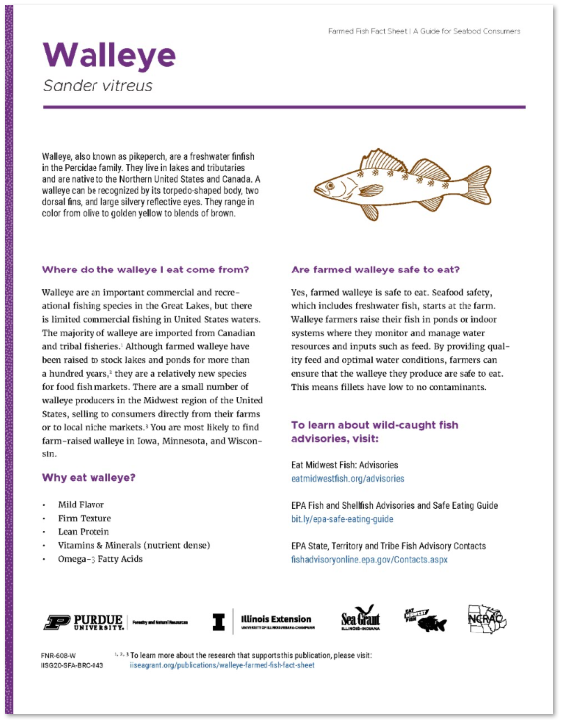Results
File Type: pdf
File Size: 1.06 MB
Year: 2021
To assist green infrastructure project managers with understanding long-term maintenance issues, Illinois-Indiana Sea Grant conducted a needs assessment. This assessment grew out of a recognition that declining infrastructure performance and sufficiency is a fundamental challenge to stormwater management over time.
Download File

File Type: pdf
File Size: 4.34 MB
Year: 2021
This is the second in a series of fact sheets that describe fish and shellfish produced in the Midwest region of the United States. (See FNR-608-W, Walleye Farmed Fish Fact Sheet.) Yellow perch have been popular among anglers for many years, and since 2002, responding to greater demand, U.S. farmers are raising perch in ponds, aquaponic systems, etc. The fact sheet also includes culinary characteristics, cooking tips and a recipe for Baked Parmesan Perch.
References:
- Pam Fuller, and Matt Neilson, 2020, Perca flavescens (Mitchill, 1814): U.S. Geological Survey, Nonindigenous Aquatic Species Database, Gainesville, FL, https://nas.er.usgs.gov/queries/factsheet.aspx?SpeciesID=820, Revision Date: 8/15/2019, Peer Review Date: 5/29/2012, Access Date: 10/14/2020
- Brown T; Runciman B; Bradford M; Pollard S, 2009. A biological synopsis of yellow perch (Perca flavescens). Canadian Manuscript Reports of Fisheries and Aquatic Sciences, 2883. 28 p.
- Hudson, J. C. and Ziegler, S. S. (2014), Environment, Culture, and The Great Lakes Fisheries. Geographical Review, 104: 391–413. doi: 10.1111/j.1931-0846.2014.12041.x
- Piavis P. Yellow perch Perca flavescens. In: Funderburk SL, Jordan SJ, Mihursky JA, Riley D, editors. Habitat requirements for Chesapeake Bay living resources. 2nd edition. Solomons, MD: Chesapeake Research Consortium; 1991. p. 14.1-14.15.
- Malison, J.A. 2003. A white paper on the status and needs of yellow perch aquaculture in the north central region. Reported prepared for North Central Regional Aquaculture Center. Available at: http://ag.ansc.purdue.edu/aquanic/ncrac/wpapers/YellowPerch11-21-03.htm
Download File

A quarterly roundup of news stories related to the ongoing work of Illinois-Indiana Sea Grant.
2020
In this issue:
IISG staff members win outreach and communication awards;
Graduate fellowship opportunities available;
New podcast series discusses the science of ponds;
Illinois Extension searching for assistant dean who will serve as IISG associate director
In this issue:
Indiana Master Watershed Steward volunteers dive in to help their local environment;
New toolkit makes finding weather and climate lesson plans easy;
Scientists bring the Great Lakes to students learning from home
In this issue:
Lake Michigan Chinook salmon stick with declining alewife as their main meal;
Sea Grant Faculty Scholars program provides new opportunities for researchers in Illinois and Indiana;
New feeding approach promises more robust and healthy farm-raised larval largemouth bass;
Amid COVID-19 pandemic, the need for frequent hand-washing collides with soaring water rates
In this issue:
Water affordability report helps inform new Chicago water billing policy;
Social norms help motivate people to adopt practices that protect water quality;
Purdue Extension Land Use Team launches American Citizen Planner program in Indiana;
Microplastics may increase the risk of PFAS entering the Lake Michigan food web
File Type: pdf
File Size: 773.78 KB
Year: 2020
Summary report for IISG’s virtual workshop that was held in October 2020 and focused on improving communication about changing lake levels and water level variability in southwestern Lake Michigan and the impacts to the Chicago metropolitan area.
Download File

File Type: pdf
File Size: 3.77 MB
Year: 2020
This fact sheet is a consumer guide to farmed walleye. The publication describes walleye, walleye farming, product safety, and culinary characteristics of walleye in addition to cooking tips and a recipe.
References:
- Summerfelt, R.C., Kinnunen, R.E., Johnson, J.A., 2019. Production of Walleye as Potential Food Fish. North Central Regional Aquaculture Center Technical Bulletin #116, NCRAC Publications Office, Iowa State University, Ames. https://www.ncrac.org/files/biblio/WFS116secure.pdf
- Summerfelt, R.C., ed. 1996. Walleye culture manual. NCRAC Culture Series #101, NCRAC Publications Office, Iowa State University, Ames, Page 5. https://www.ncrac.org/files/page/files/Chapter1.pdf
- Williams, M.C.W., Murphy, E.W., McCarty H.B., Snyder, B.D. Schrank, C.S., McCann, P.J. Crimmins, B.S. 2017. Variation in the essential fatty acids EPA and DHA in fillets of fish from Great Lakes region. Journal of Great Lakes Research, 43, Pages 150–160. https://doi.org/10.1016/j.jglr.2017.03.001
Download File
File Type: pdf
File Size: 3.66 MB
Year: 2020
This is a quick summary of IISG’s opportunities and resources to help teachers and other educators increase their Great Lakes literacy, and ultimately that of their students.
Download File
Page 13 of 41
Note: Some older Illinois-Indiana Sea Grant publications have not yet been restructured into ADA compliant formats. We are actively working on this. If you are having difficulty accessing a particular item in one of our databases, please contact iisg@purdue.edu with the name of the item and its URL for further assistance.






